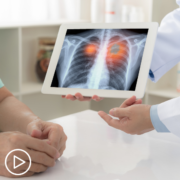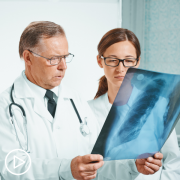Targeted Lung Cancer Therapies vs. Chemotherapy: What’s the Difference?
Targeted Lung Cancer Therapies vs. Chemotherapy: What’s the Difference? from Patient Empowerment Network on Vimeo.
Targeted lung cancer therapies and chemotherapy are both options to treat patients with lung cancer. Dr. Tejas Patil discusses the differences between these forms of therapy, including a discussion of effectiveness and side effects.
Dr. Tejas Patil is an academic thoracic oncologist at the University of Colorado Cancer Center focused on targeted therapies and novel biomarkers in lung cancer. Learn more about Dr. Patil, here.
Download Program Resource Guide
See More From INSIST! Lung Cancer
Related Programs:

Deciding on a Lung Cancer Treatment? Essential Testing for Optimal Care |

|

|
Transcript:
Katherine:
How do the newer therapies differ from the more traditional chemotherapy?
Dr. Patil:
Chemotherapy is still an important tool in an oncologist’s arsenal.
It works by killing, or rather it works by affecting a cancer cell’s ability to divide and grow. The logic here is that since cancer cells typically grow faster than normal cells, chemotherapy is more likely to kill cancer cells. It should be noted that while that is true, there are certain cells in the human body that grow very quickly as well, such as hair follicles, the lining of the mouth, and cells within the bone marrow. And so, as a result, it’s very common that the side effects of chemotherapy typically affect these cells, so you typically see hair loss. You see mucositis, or inflammation of the mouth, diarrhea, and low blood counts, and this a general side effect of chemotherapy.
Katherine:
Are there common side effects for some of the newer therapies as well?
Dr. Patil:
That’s a great question and the way I’m going to answer that is it depends on the mutation that the targeted therapy’s affecting. So, a mutation that I’m going to use as an example is a mutation called EGFR. Now, this is a mutation that we see in lung cancer that causes cancer cells to grow, divide, and metastasize.
But EGFR is interesting because it also is found in normal cells, and specifically it’s found in the cells of the skin and the gut lining. This is an example where you’re giving a very targeted therapy that’s trying to attack just the cancer cell, but because normal skin cells and gut cells have this EGFR receptor, the side effects there tend to be rash and diarrhea. Now, that’s unique to EGFR. There are other drugs such as the ALK mutation or the ROS1 mutation that do not have this side effect because that specific receptor is not found in the human body.
Katherine:
Oh, I see. Well, how is the effectiveness of treatment monitored?
Dr. Patil:
Typically, I have the philosophy that patients generally know their body and can tell when symptoms are getting better or worse. So, as a guiding principle, I rely on patient input very heavily. That being said, I corroborate that experience with some testing. In my practice, I frequently use what we call serum tumor markers, so these are very nonspecific-like tests that sort of let us know if there’s cancer type proteins in the blood that we can detect while they are on targeted therapy.
And then additionally I would recommend that patients get scans frequently, at the minimum every three months if they are on targeted therapy and doing otherwise well. That includes a CT scan of the chest and abdomen, and in certain cases, an MRI of the brain, if there were brain metastases before.










